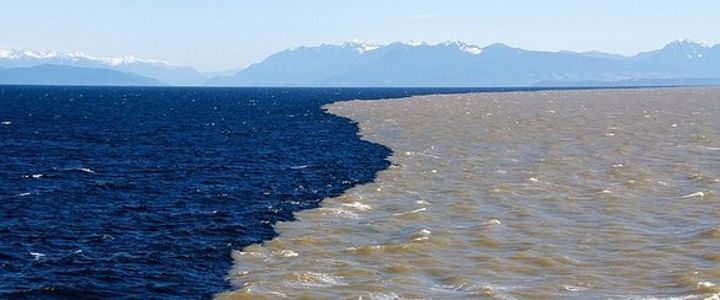“He is the One Who has released two types of bodies of water, one refreshing and sweet and the other salty and bitter – but He has established a barrier and a prohibiting partition between them.” (Quran: 25:53)
Fig. 1: The Mediterranean sea water as it enters the Atlantic over the Gibraltar sill with its own warm, saline, and less dense characteristics, because of the barrier that distinguishes between them.
Temperatures are in degrees Celsius (C°).
(Marine Geology, Kuenen, p. 43).
While the precipitation provides an ongoing supply of freshwater, this verse draws people’s attention to the storage of freshwater on the earth: how it is made available through streams, rivers, lakes and aquifers, separate and protected from bitter ocean water. This is the same reminder that was given in An-Naml (27:61), with the difference that this verse names the two types of the bodies of water and emphasizes the segregation through a formidable barrier.
This sign is to make people realize that rain is not the only aspect of water on which the life on this planet is dependent but there are many other attributes of water that contribute to the sustainability of life on the earth. It also indicates that the natural systems that Allaah has created to sustain life are complex and multifaceted but each facet or part is cohesive with the other, suggesting a design and creation of a Single Creator. In addition, water is critically responsible for life itself. Life could not have come into existence without water. The human body is about 60-70% water; even the conception of a human being is facilitated by water.
“He is the One Who created human beings from water, then He established relationships of lineage and marriage; and your Lord is Omnipotent.” (Quran: 25:54)
The Arabic word Baĥr is used for all kind of bodies of water such as rivers, lakes, oceans and water masses within oceans. Many people confuse this verse with Ar-Raĥmaan 55:19-20 –
“He released the two seas, meeting [side by side]; Between them is a barrier [so] neither of them transgresses.”
Thus, they assume that it talks about freshwater meeting the salty water but not mixing with it. The examples given for this phenomenon by leading Commentators of the Quran are freshwater springs in the coastal seas and how they remain separate from sea water for some time. Or, the examples of rivers falling into oceans and not mixing with the seawater instantly; rather, remaining visibly discernible from seawater for some time.
Other Commentators regard it as a physical earthly separation. This verse also gives a clue that salinity is a key factor in differentiating the water masses from each other. The differentiation of water masses on the basis of salinity and temperature creates ocean currents that have tremendous positive impact on the weather of the Americas and Europe.
Fig. 2: Longitudinal section showing salinity (parts per thousand ‰) in an estuary. We can see here the partition (zone of separation) between the fresh and the salt water. (Introductory Oceanography, Thurman, p. 301).
Modern science has also discovered that in estuaries, where fresh (sweet) and salt water meet, the situation is somewhat different from what is found in places where two seas meet. It has been discovered that what distinguishes fresh water from salt water in estuaries is a “pycnocline zone with a marked density discontinuity separating the two layers.” (Oceanography, Gross, p. 242).
This partition (zone of separation) has a different salinity from the fresh water and from the salt water. (Oceanography, Gross, p. 244, and Introductory Oceanography, Thurman, pp. 300-301).


Hi you have a user friendly site It was very easy to post I enjoyed your site